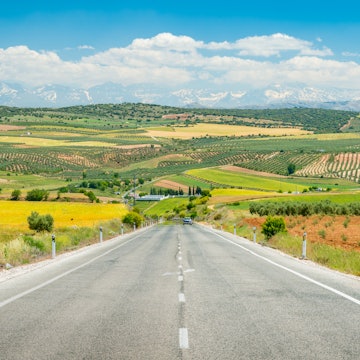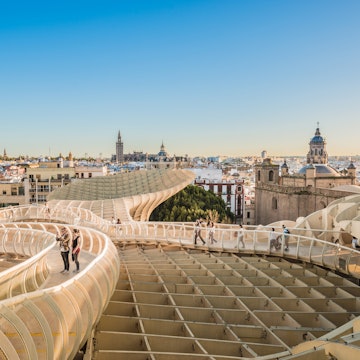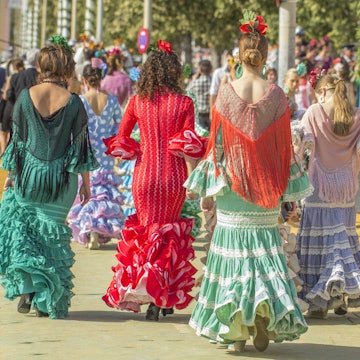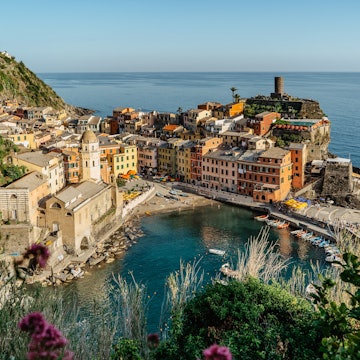
Find your way around Seville with our top transportation tips

Aug 29, 2024 • 6 min read

Find your way around Seville with these top tips on transportation, tickets, and accessibility. Eo Naya/Shutterstock
Seville is a city built for walking. The traffic-free cobbled streets, riverside promenades, parks and squares mean there are plenty of reference points to help you avoid getting lost. And, if your curiosity does take you far from where you started with tired feet and a desire to get back to your hotel quickly, you’ll always have access to half a dozen convenient forms of efficient and accessible public transport.
With e-scooters, a Metro line, the city’s tram and Sevici bicycle hire networks, here are some top tips to help you get around in Seville with ease.
Central Seville is best explored on foot
Be sure to pack comfortable shoes because Seville’s historic core is a maze of winding streets. Most neighborhoods you’re likely to visit – including Barrio Santa Cruz, Centro, Triana, El Arenal, La Macarena, and Alameda de Hércules – are best explored on foot. In Barrio Santa Cruz, there are even occasions where a cobbled alley is only wide enough for one person to pass through at a time.
In general, the majority of city center streets in Spain’s fourth largest city are so narrow that they prohibit most traffic (you’ll frequently see scrape marks on buildings, where a driver has misjudged their margins). Public transport options are therefore limited to a tram and a few bus routes.

Hire a bike to go beyond the city center
Walking isn’t an imperative means of exploration in central Seville, thanks to handy schemes such as the Sevici public bike share. Bikes can be rented using the Sevici app at the hundreds of docking stations throughout the city. Usage costs as little as €2.59 for one day, or €13.33 for one week. This covers all journeys of 30 minutes or less, with incremental price increases for longer rentals. Major roads around the city are shadowed by dedicated bicycle lanes, painted green. Two popular routes include the cycle lanes along the River Guadalquivir and the route out to Isla Mágica, through the old Expo ’92 site.
If cycling sounds like a little too much exertion, there are similar sharing programs for e-bikes (Lime), e-scooters (various, including Voi) and electric mopeds (YEGO). Moped rental starts at around €10 for around 30 minutes and includes helmets and insurance. Be aware that pedestrianized zones of the city are off-limits to two-wheeled transportation.
Know your Metro from your MetroCentro
Public transit in Seville does a great job of connecting the outer areas of the city to its core, but there is little to connect the central neighborhoods to one another. One exception is the efficient, seven-stop tram line called the MetroCentro. It runs from Plaza Nueva along the Avenida de la Constitución, past the cathedral. In 2024, an extension as far as Nervión (close to Sevilla FC’s stadium) opened. There are plans to extend the line to Sevilla-Santa Justa train station. Operating hours are from 6am until 11:30pm.
Not to be confused with the MetroCentro tram, the modern Seville Metro light rail opened its single west–southeast L1 line in 2010. The line skirts south of Seville Centro with three central stations: Puerta Juarez (close to the Real Alcázar), Prado de San Sebastián (close to Plaza de España) and San Bernardo for the regional train station. Construction on a second, north–south line began in mid-2024, and is projected to open in 2030. It operates from 6:30am until 11pm, extending until 2am on Fridays and Saturdays.
Ditch the car and take a taxi into central Seville
Chances are, if you’re staying even remotely centrally in Seville, you won’t use a car while exploring the city. While most central neighborhoods are accessible to vehicles, the narrow streets are usually filled with pedestrians and, due to the one-way system, are a hassle to navigate. Parking is almost non-existent and pricey when available. Most hotels offering guest parking are located in the city suburbs.
But there are times when taxis come in handy. If you’ve only just arrived at the bus or train station and your accommodation is somewhere in that pedestrian-friendly central zone of Seville, a taxi is the best way to get you and your luggage to the check-in desk. Use the white taxis with diagonal yellow stripes or Uber. A cross-town taxi from Sevilla-Santa Justa to the Universidad de Sevilla costs around €10 in the daytime. Local taxi drivers are particularly adept at navigating the tightest of corners, making light work of the tricky Centro streets.
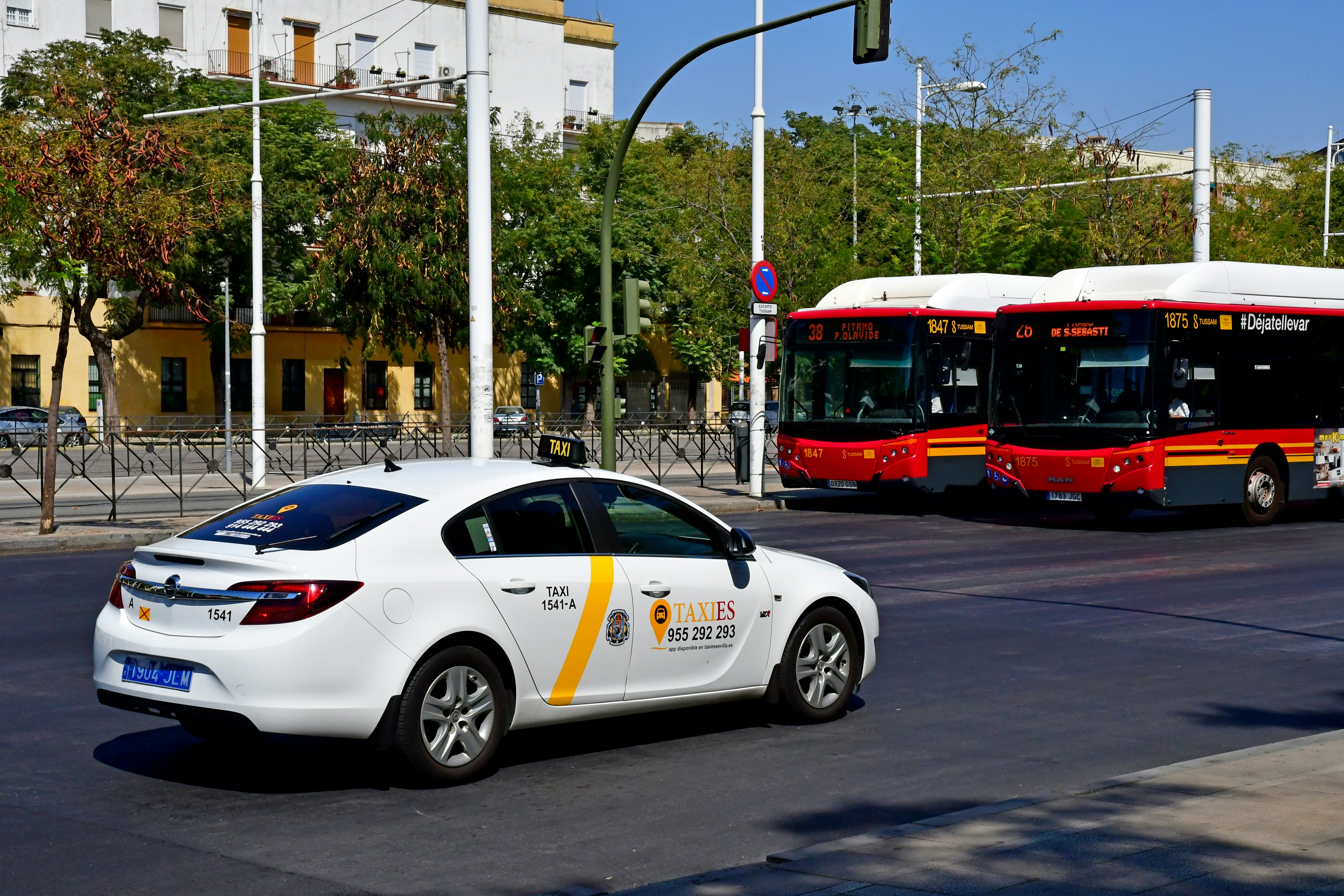
Buses are great for exploring further afield
Seville’s bus network connects the various suburbs and satellite towns to the fringes of Seville Centro. Bus 32 stops at Sevilla-Santa Justa train station on its way to Plaza Ponce de León (near Las Setas). Most bus routes stop along the main roads circling Centro, such as the north–south buses 1 and 3, which flank the east and west sides respectively. Bus 5 connects Triana to the southern edge of Centro.
Another company, CTAS, runs bus M170 (A and B) hourly from Plaza de Armas bus station to the Roman ruins at Itálica. Most buses run from around 6am until 11:30pm.
Seville’s main transport hubs are linked by the EA airport bus
Visitors are most likely to arrive into, and depart from, Seville via either Santa Justa train station, Seville Airport, or Plaza de Armas bus station. The EA airport bus connects all three, stopping beside the Torre del Oro along the way. No matter if you’re leaving or arriving, it makes for an affordable way to get you and your luggage to your departure on time. The first bus of the day leaves from outside Plaza de Armas heading for the airport at 4:30am, with the last one at around midnight. From the airport, the first bus departs at 5:20am, and the last one leaves at 1am. During peak hours from 8am to 8pm, there are roughly four buses an hour. The fare is €4 one way.
Save money with transport passes
Public transportation in Seville is supremely affordable. Single tickets on the Metro range from €1.35 to €1.80, depending on the distance you ride and can be bought from the ticket machines at each station. Scan the paper tickets at the barriers on entry and exit.
One-way tickets on the MetroCentro tram and buses (which are both run by Tussam) cost €1.40. Bus tickets can be bought on board, tram tickets are available at machines at each stop.
Tussam offers two unlimited-use tourist passes (Tarjeta turista), valid across its network (except the airport bus), for one or three days (€5 or €10, plus a €1.50 deposit). Both are worthwhile if you plan to take more than a couple of rides a day. Buy these from the Tussam information stands at Prado San Sebastián, Plaza Ponce de León, or at 11 Avenida Andalucía. For longer stays, it might be worth getting a rechargeable Tarjeta multiviaje. The card costs €1.50 and you have to add a minimum of €7 to get started, but it reduces your one-way trip fare to €0.69.
There is accessible transportation in Seville
Apart from the cobbled streets around the Catedral, which may make wheeling difficult, most streets in central Seville are flat and fairly accessible to those with restricted mobility. Many of the museums and major sights, including the Real Alcázar, which has a designated wheelchair-friendly route, have good facilities for those with mobility restrictions. All public transport, including the Metro (which has lifts), MetroCentro and buses are wheelchair accessible and have priority seating.













